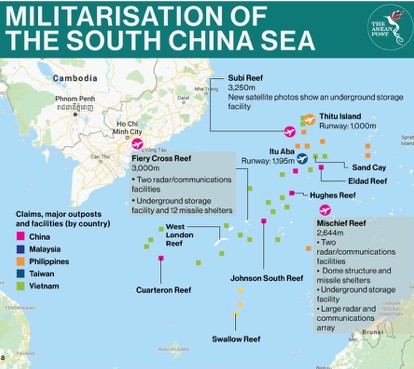Though the Russia-Ukraine crisis has hijacked the world attention, three flashpoints in Asia – Taiwan Straits, South China Sea and Korea’s nuclear/missile issues – continue to remain alive. Given the bonhomie that has developed between Russia and China, there is a fear that when the world’s attention is focussed on Ukraine, China might feel emboldened to further expand its aggrandizement in the South China Sea. There remains a fear that China might indulge in some adventurism in the Senkakus to riddle Japan and even to provoke India by incursions in its border.
The 10-member Asean grouping finds itself in the receiving end of Chinese assertiveness, especially in the South China Sea. When the Asean nations are trying to come into grip with the Covid pandemic, China is busy in building its presence in the territories it has occupied in the South China Sea. In March 2022, China launched two new research stations on the Chinese-built artificial islands at Fiery Cross Reef and Subi Reef. Their purpose is to study a wide range of marine sciences, including ecology, geology, environment, mineral, and energy resources of the South China Sea. Maritime experts believe that these research stations are alleged to be part of China’s plans in ramping-up its exploitation of the deep-sea environment in its search for fuel, rare metals and biotechnology in the waters. The 2016 Arbitral ruling had categorically mentioned that such stations are not acceptable as those are not part of its exclusive economic zone and therefore illegal.
Malaysian waters are the latest where the Chinese navy has been active. In a salami-slicing move, China’s Hiyang Dizhi 8 entered Malaysian waters in early May 2022 and was close to the West Capella, an exploration vessel owned by Petronas. Earlier, the Chinese vessel sank a Vietnamese fishing boat and slowly encroaching in claimants’ territories, thereby intensifying its occupation of the South China Sea.
The Haiyang Dizhi 8 left port at Sanya on Hainan Island on 9 April, went through Vietnamese waters and then entered the waters of Malaysia and Brunei on 17 April. This is the latest flashpoint and a new move by China by setting up new administrative structures in the disputed waters. China plans the two new districts to be under the authority of the local governments in Sansha, a city in the southern island of Hainan, governing the Paracel and Macclesfield Bank, an area claimed by Vietnam and Taiwan, and the Spartly Islands and their adjacent waters where there are multiple overlapping claims. As expected, Chinese move has evoked outcry by international analysts and governments.
The US has been forthright in demanding that China stops exploiting the distraction or vulnerability of other states to expand its unlawful claims in the South China Sea. In a statement on 18 April, the US State Department warned that China should cease its bullying behaviour and refrain from engaging in this type of provocative and destabilising activity.

Understandably, Vietnam felt provoked. Vietnam’s Foreign Ministry spokeswoman, Le Thi Thu Hang, complained that the establishment of the so-called Sansha City and related activities violated Vietnam’s sovereignty. She demanded that China respect Vietnam’s sovereignty and abolishes its wrongful decisions. Former Foreign Secretary of the Philippines, Albert Del Rosario lso accused China of exploiting the new coronavirus pandemic to advance its “illegal” claims in the waters. Other experts also condemned China’s activities in the South China Sea. Politic analyst Carl Thayer from the University of New South Wales called China’s latest action “provocative,” “illegal” and has no basis under international law. According to him, international law does not recognise sovereignty acquired through conquest. Beijing’s move also violates the Declaration on Conduct of Parties in the South China Sea (DOC) that was agreed to by China and ASEAN member states in 2002. Thayer pointed out that Paragraph 5 of the DOC states that the Parties undertake to exercise self-restraint in the conduct of activities that would complicate or escalate disputes and affect peace and stability in the South China Sea.
What is the collective response of ASEAN to this Chinese adventure? While Chinese actions defy international and sea laws guiding the exclusive economic zones of every country in the South China Sea, ASEAN must stand together and act to prevent the colonisation of the seas by China. While the ASEAN needs to stand together and play a central role in resolving conflicts and de-escalate tensions. In this endeavour, ASEAN is not alone. The US, India, Japan and Australia, all members of the Quad, also realise the need to contain Beijing’s activities and the importance of strengthening the ASEAN. The unanimous opinion of all four Quad members is that ASEAN’s centrality in the Indo-Pacific must be maintained. Unless all stakeholders practice restraint and comply with international law, especially the UNCLOS and the DOC, the environment of escalating conflict cannot be secured. There is an urgency that China and the ASEAN should speed of finalising the DOC, which shall be legally binding, meaningful, effective, and consistent with international law.
How China embraces Cambodia?
Cambodia, the current ASEAN Chair, is perceived to be close to China. This is a matter of worry for the rest of the ASEAN members. The news of Cambodia offering China to set up a base in Cambodia on the Gulf of Thailand providing Chinese People’s Liberation Army Navy (PLAN) with a new southern flank in the South China Sea is worrying. A new base could strengthen the Chinese navy near the highly strategic Strait of Malacca, through which an estimated 80 percent of China’s fuel imports travel. It may be remembered that the US in October 2020 had flagged concerns over Cambodian government tearing down a US-funded building used for a maritime security program and felt that the facility shall be used by the Chinese PLAN.
Though it is known that Cambodia has a cosy relationship with Beijing for many years, the controversy began over the news when it surfaced that China is getting a 30-year lease of the Ream Naval Base on the Gulf of Thailand where China would post military personnel and store weapons and berth warships. The base is operated by the Royal Cambodian Navy in the province of Sihanoukville, Cambodia, and covers 290 acres. Since 2020 it was the site of annual joint Cambodian-US training and naval exercises under the Cooperation Afloat Readiness and Training program. The decision of Cambodia to demolish a seven year old maritime security facility will surely negatively impact the US-Cambodia bilateral relationship and be disruptive and destabilizing to the Indo-Pacific region.
A Chinese base in Cambodia on the Gulf of Thailand would provide the PLAN with a new southern flank in the South China Sea and improve its ability to respond to any conflict near the highly strategic Strait of Malacca, through which an estimated 80 percent of China’s fuel imports travel. Though Cambodia’s Prime Minister Hun Sen said that ships from other countries can make port visit as the dockyards would be open to all, since the Ream Naval Base remains a military port, they need prior permission.
Position of Vietnam
Vietnam is the only country in the ASEAN grouping that has taken a position to be admired. It can be argued that despite that the US was an adversary as it occupied Vietnam and had to face defeat after a prolonged war has found common viewpoints on global governance rules and sides with Vietnam with those threatening to violate Vietnam’s sovereignty. It would not be wrong to say that China’s belligerence, territorial ambitions and bombastic rhetoric has driven Vietnam to the US camp where it finds common viewpoint. A recent report by ISEAS-Yusof Ishak Center notes that an overwhelming 73 per cent of Vietnamese would align with the US over China if forced to choose. China might not rejoice this announcement as it values Vietnam as a neutral actor in its competition with the US for hegemony in Asia.
It may be recalled that in 2014 when the Chinese stationed an oil rig in disputed territory it led to a tense standoff between Vietnam and China, leading to violent protests across the country that targeted ethnic Chinese and their businesses. This led to the death of 21 people. Vietnam feels threatens to its autonomy because of Chinese actions. This in turn fuels Vietnamese nationalism and thus restricts Hanoi’s willingness to engage with Beijing. Such a situation presents an ideal opportunity for the US to deepen its strategic and military relationship with Vietnam. In the emerging great power competition in the Indo-Pacific region, Vietnam is an important and significant cog.
Indeed the ASEAN as a regional grouping offers huge opportunity for the growth of world economy. With its combined population of 667 million and an aggregate GDP of $3 trillion, ASEAN is set to become the world’s fourth largest economy by 2030. The recent US-ASEAN summit failed to adequately address the trade and investment opportunity in the much touted Indo-Pacific Economic Framework. Interestingly, the Biden administration and the ASEAN leaders put an empty chair to represent Myanmar’s overthrown civilian government during the summit meeting. The US needs to unlock the opportunities in an economically vibrant region at a time when China’s influence is constantly growing. The just-concluded visit of Vietnamese Prime Minister to Washington appropriately addressed to some of these issues. By Dr. Rajaram Panda/ eurasiareview




